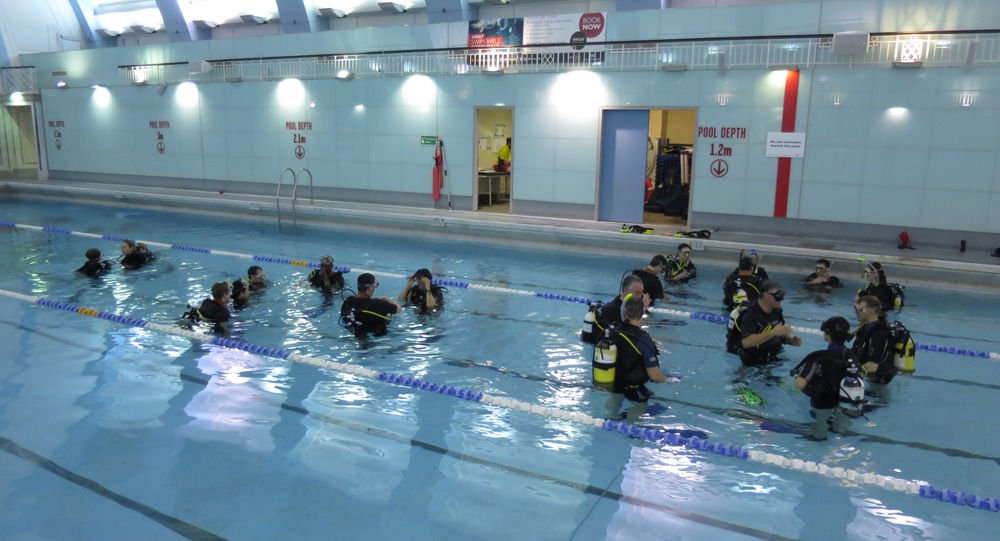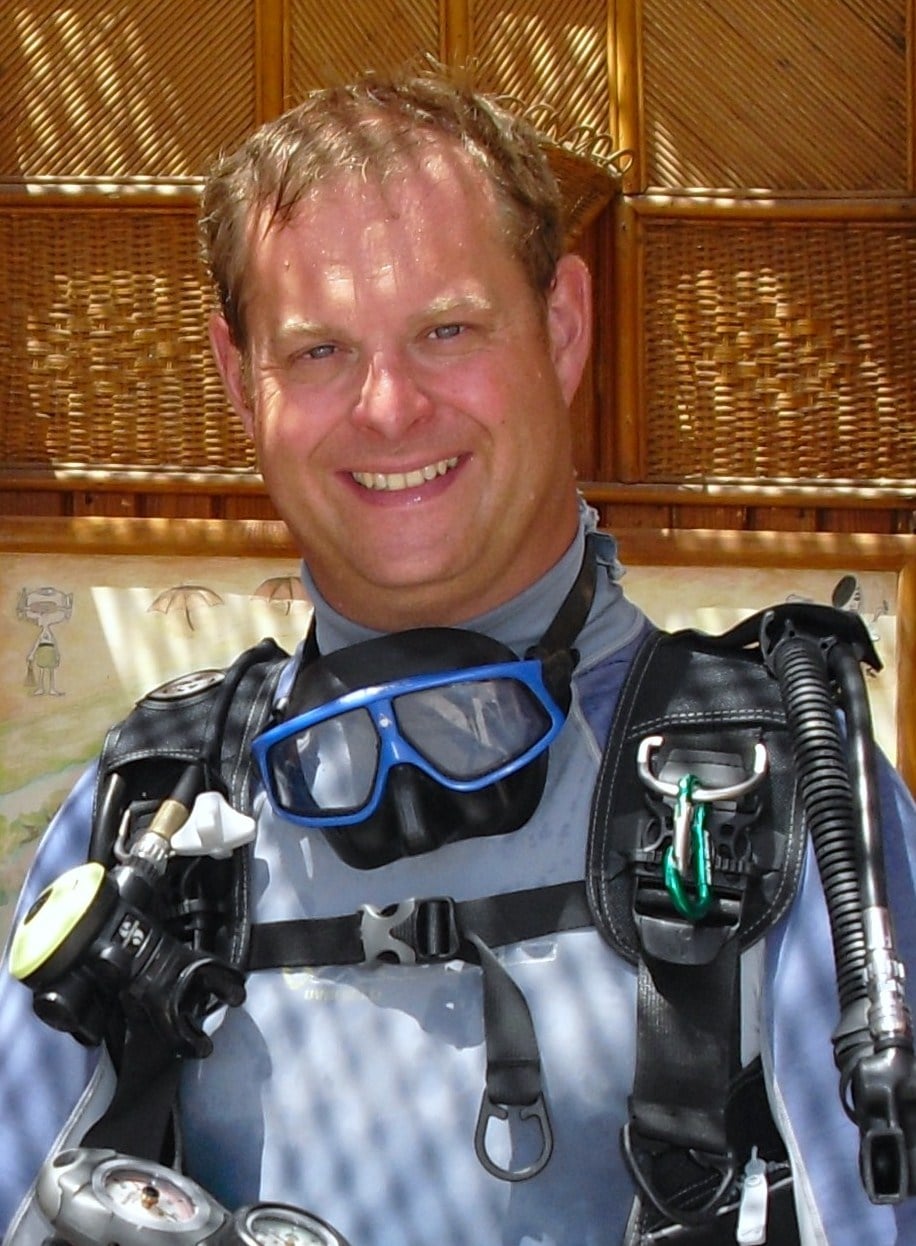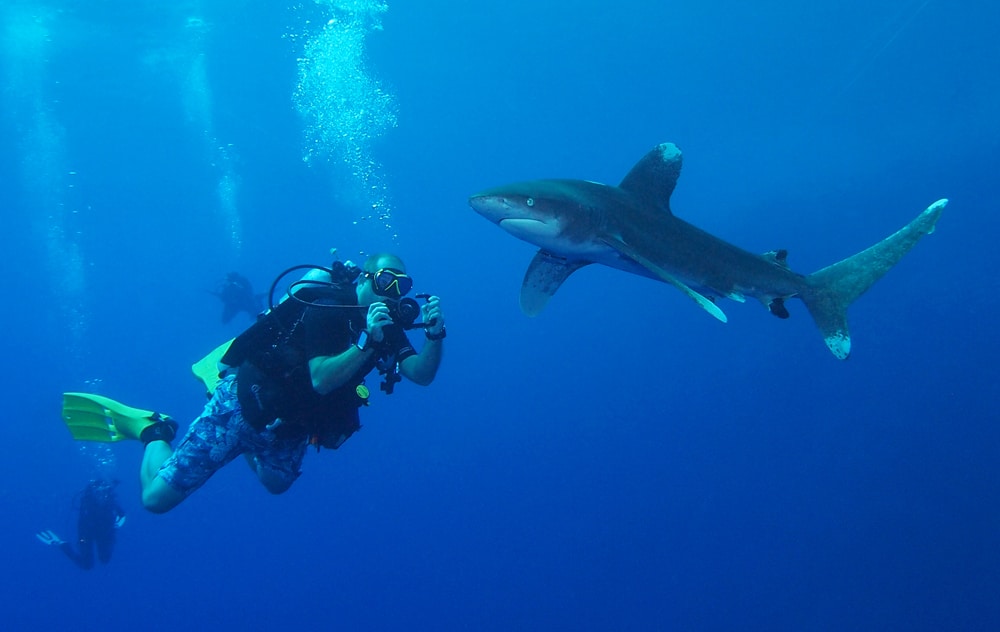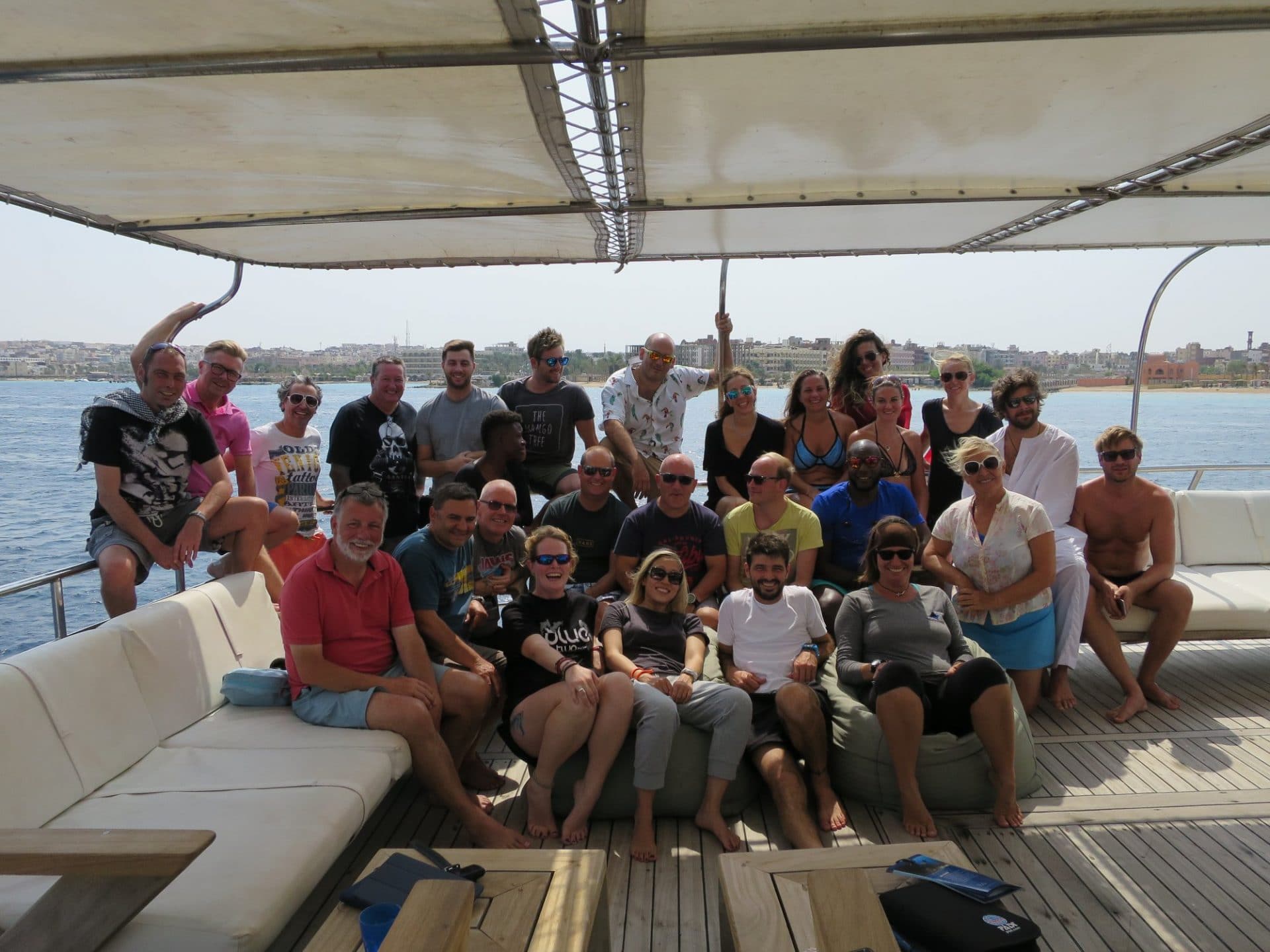News
Diving with…Mark Murphy, Oyster Diving: London, Surrey, Berkshire, Oxfordshire, Kent, Hertfordshire and Sussex

In this ongoing series, we speak to the people who run dive centres, resorts and liveaboards from around the world about their businesses and the diving they have to offer…
Mark Murphy
What is the name of your business?
Oyster Luxury Travel & Diving Ltd
What is your role within the business?
Managing Director
How long has the business operated for?
12 years
How long have you dived for, and what qualification are you?
I did my first Discover Scuba in the South of France in 1997 and completed my Open Water in 1999. I am currently a PADI Master Scuba Diver Trainer and have been teaching for 14 years.
What is your favorite type of diving?
Shark diving! There are few things in life that are as exhilarating as diving with sharks. They are amazing creatures that have been around since before the dinosaurs.
If you could tell people one thing about your business (or maybe more!) to make them want to visit you what would it be?
We are a professionally run 5 star PADI dive centre offering courses from beginner to instructor. Incorporated is a fully bonded travel centre which means we can offer holidays around the world as well as UK trips to our customers and club members. We stock the major brands of diving equipment at competitive prices and are proud to be an Aqua Lung partner centre. We have 6 pool locations around the South East to make it as easy as possible for customers to take their first breaths underwater.
What is your favorite dive in your location and why?
I’ve been really fortunately to have been to some truly amazing places including the Med, Red Sea, Mexico, Thailand, Virgin Islands, Barbados, Sudan, UK, Australia and Djibouti but nothing has ever come close to the Galapagos. The shear abundance of marine life, the giant schools of hammerheads and huge whale sharks is unlike anywhere else on earth. It’s very expensive but worth every penny.
What types of diving are available in your location?
We offer dives around the UK and we have regular boat dives off the South Coast close to our offices in Brighton. We also visit some of the inland sites to complete training and allow newer dives to gain additional experience.
What do you find most rewarding about your current role?
Since we’ve become one of the largest dive centres in the UK I find that I am spending less time teaching courses then I used to. So, I’m always really pleased to receive thank you emails from customers that we have taught as it means that all the hard work we put in is paying off and our instructors and Divemasters are doing a great job.
What is your favorite underwater creature?
After sharks I love big schools of fish. Watching hundreds of barracudas swirling round and following each other’s tails is great to watch. However, I could also just plonk myself on the sand (carefully of course) and spend hours just watch clown fish dancing around their anemone.
Are there any exciting changes / developments coming up in the near future?
We have recently taken delivery of Ocean Reef Full Face masks with underwater comms so we can’t wait for our customers and instructors to give these a whirl. We’ve also just become stockists for Paralenz so it means that the quality of the videos we and our customers produce on our trips will be even better – even our most technophobes can operate them.
As a center what is the biggest problem you face at the moment?
The biggest problem Oyster Diving face in the UK is awareness of the ‘referral system’. Many people in the UK have the idea that diving in the UK is dark and cold and don’t realise that you can complete the theory and pool skills saving on valuable holiday time. If the industry could generate more awareness of the referral system then it would allow our instructors to educate people about ways to keep warm and talk about some of the great dive sites we have in this country. This means they could carry on diving on returning from holiday and continue their new passion instead of just forgetting about it and moving on to the next challenge.
I find that the other challenge in the UK is getting new divers boat diving in the sea. If you look at most of the dive boats these days they have an aging population of men on them who have been diving for years. I believe the one of the reasons for this is that many of the dive boats don’t offer the same level of service that people find on their overseas holiday. So, when people do go for their first UK sea dive they are usually disappointed, feel uncared for or are just scared.
A lot of new divers are understandably anxious when they do their first sea dive. I think it would be great for the industry to have boats that offer proper briefings, an experienced guide that knows the dive site and an option for some decent food (even if it’s sandwiches and hot chocolate) or a few few other luxuries.
We are trying to introduce this level of service to our South Coast boat dives but without owning our own boat it is very difficult.
Is your center involved in any environmental work?
We believe that as divers we are the ambassadors for the underwater world and need to educate people on the impact that our lifestyles are having on the environment. We have set up some corporate dive clubs where we give regular talks on what we can do to help our oceans. We regularly post on our social media and newsletters with the latest news. We have run many ‘Project Shark’ trips with blue o two which have also encouraged many of our customers to spread the word about the plight of many shark species.
How do you see the SCUBA / Freediving / snorkeling industry overall? What changes would you make?
I think in the modern age of cheap and fast travel it gives us a great opportunity to visit destinations that would never have accessible to our parents. I would like to see more schools offering diving and holidays to accompany their usual annual ski trip. Diving offers kids the chance to put many of their subjects they learn such as physics, chemistry, maths, biology and history in to practice in a fun and rewarding manner. Unlike many school sports you don’t have to be a great sportsperson to be a great diver so everyone can get involved regardless of age and sex.
On school trips we run we find the students really bond with each other despite being in different year groups and coming from different backgrounds and it makes them much more sociable when they return home as well as having a new passion that can be used in a future career.
What would you say to our visitors to promote the diving you have to offer?
I would say come along to one of drinks nights in London or Brighton and meet some new friends. We have a great crowd with people from all different ages, different levels of dive experience and from different backgrounds from bin men to wealthy stock brokers. By meeting like-minded friendly people opens up the opportunity to join our holidays around the world and have some amazing experiences.
Where can our visitors find out more about your business
We have two websites:
Dive School, Club and Holidays – www.oysterdiving.com
Online dive shop www.oysterdivingshop.com
We have a freephone number 0800 699 0243 and people are always welcome to e-mail us at info@oysterdiving.com.
Blogs
Northern Red Sea Reefs and Wrecks Trip Report, Part 3: The Mighty Thistlegorm

Jake Davies boards Ghazala Explorer for an unforgettable Red Sea diving experience…
Overnight, the wind picked up, making the planned morning dive a bit bumpy on the Zodiacs to the drop point on Thomas Reef. There, we would dive along the reef before descending through the canyon and then passing under the arch before ascending the wall with a gentle drift. The site provided great encounters with more pelagic species, including shoals of large barracuda, tuna, and bigeye trevally.
Once back on the boat, it was time to get everything tied down again as we would head back south. This time, with the wind behind us, heading to Ras Mohammed to dive Jackfish Alley for another great gentle drift wall dive before then heading up the coast towards the Gulf of Suez to moor up at the wreck of the Thistlegorm. This being the highlight wreck dive of the trip and for many onboard, including myself, it was the first time diving this iconic wreck. I had heard so much about the wreck from friends, and globally, this is a must on any diver’s list. Fortunately for us, there was only one other boat at the site, which was a rarity. A great briefing was delivered by Ahmed, who provided a detailed background about the wreck’s history along with all the required safety information as the currents and visibility at the site can be variable.

Kitting up, there was a lot of excitement on deck before entering the water and heading down the shoreline. Descending to the wreck, there was a light northerly current which reduced the visibility, making it feel more like the conditions that can be found off the Welsh coast. At 10m from the bottom, the outline of the wreck appeared as we reached the area of the wreck which had been bombed, as our mooring line was attached to part of the propeller shaft. Arriving on deck, instantly everywhere you looked there were many of the supplies which the ship was carrying, including Bren Carrier tanks and projectiles that instantly stood out.

We headed around the exterior, taking a look at the large propeller and guns mounted on deck before entering the wreck on the port side to take a look in the holds. It was incredible to see all the trucks, Norton 16H, and BSA motorcycles still perfectly stacked within, providing a real snapshot in time.

Overall, we had four dives on the Thistlegorm, where for all of the dives we were the only group in the water, and at times, there were just three of us on the whole wreck, which made it even more special, especially knowing that most days the wreck has hundreds of divers. Along with the history of the wreck, there was plenty of marine life on the wreck and around, from big green turtles to batfish, along with shoals of mackerel being hunted by trevally. Some unforgettable dives.

The final leg of the trip saw us cross back over the Suez Canal to the Gobal Islands where we planned to stay the night and do three dives at the Dolphin House for the potential of sharing the dive with dolphins. The site, which included a channel that was teeming with reef fish, especially large numbers of goatfish that swam in large shoals along the edge of the reef. These were nice relaxing dives to end the week. Unfortunately, the dolphins didn’t show up, which was okay as like all marine life they are difficult to predict and you can’t guarantee what’s going to be seen. With the last dive complete, we headed back to port for the final night where it was time to clean all the kit and pack before the departure flight the next day.

The whole week from start to finish on Ghazala Explorer was amazing; the boat had all the facilities you need for a comfortable week aboard. The crew were always there to help throughout the day and the chefs providing top quality food which was required after every dive. The itinerary providing some of the best diving with a nice mixture of wreck and reef dives. I would recommend the trip to anyone, whether it’s your first Red Sea liveaboard in the Red Sea or you’re revisiting. Hopefully, it’s not too long before I head back to explore more of the Red Sea onboard Ghazala Explorer.

To find out more about the Northern Red Sea reef and wrecks itineraries aboard Ghazala Explorer, or to book, contact Scuba Travel now:
Email: dive@scubatravel.com
Tel: +44 (0)1483 411590
Photos: Jake Davies / Avalon.Red
Blogs
Northern Red Sea Reefs and Wrecks Trip Report, Part 2: Wall to Wall Wrecks

Jake Davies boards Ghazala Explorer for an unforgettable Red Sea diving experience…
The second day’s diving was a day full of wreck diving at Abu Nuhas, which included the Chrisoula K, Carnatic, and Ghiannis D. The first dive of the day was onto the Chrisoula K, also known as the wreck of tiles. The 98m vessel remains largely intact where she was loaded with tiles which can be seen throughout the hold. The stern sits at 26m and the bow just below the surface. One of the highlights of the wreck is heading inside and seeing the workroom where the machinery used for cutting the tiles are perfectly intact. The bow provided some relaxing scenery as the bright sunlight highlighted the colours of the soft coral reef and the many reef fish.

Following breakfast, we then headed to the next wreck, which was the Carnatic. The Carnatic is an 89.9m sail steamer vessel that was built in Britain back in 1862. She ran aground on the reef back in 1869 and remains at 27m. At the time, she was carrying a range of items, including 40,000 sterling in gold. An impressive wreck where much of the superstructure remains, and the two large masts lay on the seafloor. The wooden ribs of the hull provide structures for lots of soft corals, and into the stern section, the light beams through, bouncing off the large shoals of glass fish that can be found using the structure as shelter from the larger predators that are found outside of the wreck.

The final wreck at Abu Nuhas was the Ghiannis D, originally called ‘Shoyo Maru,’ which was 99.5m long and built in Japan back in 1969 before becoming a Greek-registered cargo ship in 1980. The ship then ran aground on the reef on April 19th, 1983, and now sits at the bottom at a depth of 27m. Heading down the line, the stern of the ship remains in good condition compared to the rest of the hull. The highlight of the wreck, though, is heading into the stern section and down the flights of stairs to enter the engine room, which remains in good condition and is definitely worth exploring. After exploring the interior section of the ship, we then headed over to see the rest of the superstructure, where it’s particularly interesting to see the large table corals that have grown at the bow relatively quickly considering the date the ship sank. After surfacing and enjoying some afternoon snacks, we made sure everything was strapped down and secured as we would be heading north and crossing the Gulf of Suez, where the winds were still creating plenty of chop.

The next morning, it was a short hop to Ras Mohammed Nature Reserve for the next couple of days of diving. The 6am wake-up call came along with the briefing for the first site we would be diving, which was Shark & Yolanda. The low current conditions allowed us to start the dive at Anemone City, where we would drift along the steep, coral-filled wall. These dives involved drifts, as mooring in Ras Mohammed wasn’t allowed to protect the reefs. As a dive site, Shark & Yolanda is well-known and historically had a lot of sharks, but unfortunately not so many in recent years, especially not so early in the season. However, there was always a chance when looking out into the blue.

The gentle drift took us along the steep walls of the site, with plenty of anemone fish to be seen and a huge variety of corals. It wasn’t long into the dive before we were accompanied by a hawksbill turtle, who drifted with us between the two atolls before parting ways. Between the two reefs, the shallow patch with parts of coral heads surrounded by sand provided the chance to see a few blue-spotted stingrays that were mainly resting underneath the corals and are always a pleasure to see. With this being the morning dive, the early sunlight lit up the walls, providing tranquil moments. Looking out into the blue, there was very little to be seen, but a small shoal of batfish shimmering underneath the sunlight was a moment to capture as we watched them swim by as they watched us.

Towards the end of the dive, we stopped at the wreck of the Jolanda where the seafloor was scattered with toilets from the containers it was carrying. This provided a unique site to make a safety stop, which was also accompanied by a large barracuda slowly swimming by, along with a hawksbill turtle calmly swimming over the reef as the sun rays danced in the distance.
For the next dive, we headed north to the Strait of Tiran to explore the reefs situated between Tiran Island and Sharm El Sheik, which were named after the British divers who had found them. We started on Jackson before heading to Gordons Reef, where we also did the night dive. All the atolls at these sites provided stunning, bustling coral reefs close to the surface and steep walls to swim along, which always provided the opportunity to keep an eye out for some of the larger species that can be seen in the blue. Midwater around Jackson Reef was filled with red-toothed triggerfish and shoals of banner fish, which at times were so dense that you couldn’t see into the blue. Moments went by peacefully as we enjoyed the slow drift above the reef, watching these shoals swim around under the mid-afternoon sun.

The night dive at Gordon’s Reef was mainly among the stacks of corals surrounded by sand, which was great to explore under the darkness. After some time circling the corals, we came across what we were really hoping to find, and that was an octopus hunting on the reef. We spent the majority of the dive just watching it crawl among the reef, blending into its changing surroundings through changes in colour and skin texture. It’s always so fascinating and captivating to watch these incredibly intelligent animals, in awe of their ability to carry out these physical changes to perfectly blend into the reef. Before we knew it, it was time to head back to the boat to enjoy a well-deserved tasty dinner prepared by the talented chefs onboard.
Check in for the 3rd and final part of this series from Jake tomorrow!
To find out more about the Northern Red Sea reef and wrecks itineraries aboard Ghazala Explorer, or to book, contact Scuba Travel now:
Email: dive@scubatravel.com
Tel: +44 (0)1483 411590
Photos: Jake Davies / Avalon.Red
-

 News3 months ago
News3 months agoHone your underwater photography skills with Alphamarine Photography at Red Sea Diving Safari in March
-

 News3 months ago
News3 months agoCapturing Critters in Lembeh Underwater Photography Workshop 2024: Event Roundup
-

 Marine Life & Conservation Blogs2 months ago
Marine Life & Conservation Blogs2 months agoCreature Feature: Swell Sharks
-

 Blogs2 months ago
Blogs2 months agoMurex Resorts: Passport to Paradise!
-

 Blogs2 months ago
Blogs2 months agoDiver Discovering Whale Skeletons Beneath Ice Judged World’s Best Underwater Photograph
-

 Gear Reviews3 months ago
Gear Reviews3 months agoGear Review: Oceanic+ Dive Housing for iPhone
-

 Marine Life & Conservation2 months ago
Marine Life & Conservation2 months agoSave the Manatee Club launches brand new webcams at Silver Springs State Park, Florida
-

 News3 months ago
News3 months agoWorld’s Best Underwater Photographers Unveil Breathtaking Images at World Shootout 2023




















